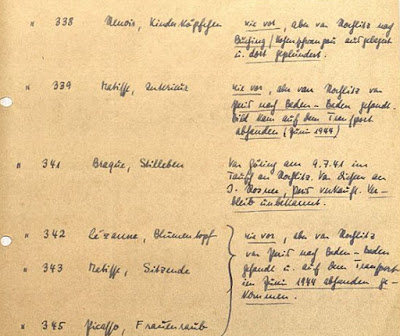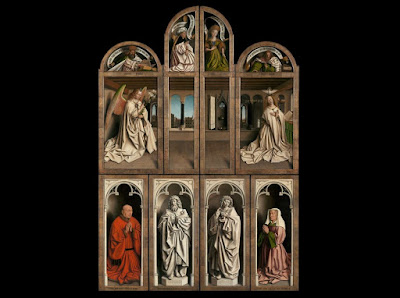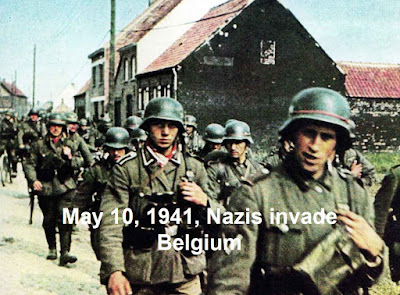July 10, 2021
THE WORLD’S GREATEST TREASURE HUNT
The search for Nazi stolen art has been called the greatest treasure hunt in history. The supreme prize among the treasures was The Adoration of the Mystic Lamb. And the fate of The Lamb during the Second World War, along with that of most of Europe’s artistic masterpieces, was sealed by a Parisian secretary, the heroism of an Austrian double agent, a group of salt miners, and a fortuitous toothache.
In May 1940 the German army invaded Belgium, and the Belgian government sought a safe place to hide its prized artworks. First, a truck carrying The Ghent Altarpiece in ten large wooden crates was en route to Italy when Italy joined the Axis and declared war.
France then offered to guard The Lamb at Chateau de Pau at the foot of the Pyrenees. Much of the Louvre’s art was already there. The Chateau de Paul became a depository for looted art.
With each defeat of the French army, Jaujard ordered the crated art treasures shipped to locations that seemed safe from harm’s way.
The Nazis were harvesting Europe’s art treasures for Adolf Hitler’s grand plan to create a super museum, to be located in his boyhood hometown of Linz, Austria. Even the art that Hitler considered “degenerate” would be placed in a special section to be viewed by future generations as evidence of the grotesqueries from which the Nazis had saved humankind.
Hitler authorized the Exhibition of Depraved Art. In all, 12,000 drawings and 5,000 pictures and sculptures were seized. These included works by Cezanne, van Gogh, Munch, and Picasso. Hitler stated that on no account would any be returned, nor would any compensation be given.
Hitler was not the only Nazi leader who collected art through war looting. Foremost among Nazi private collectors was Luftwaffe Reichsmarschall Hermann Goring. The Reichsmarschall assembled an enormous collection at Carinhall, his estate near Berlin. As the war began, Goring said, “I plan to plunder, and to do so thoroughly.”
His preference for Germanic art and artists was such that he once traded 150 authentic 19th century Impressionist and Post-Impressionist French paintings, looted from Paris galleries, for one Vermeer, Christ and the Woman Taken in Adultery, which turned out to be a fake by the Dutch master forger Han van Meegeren.
Van Meegeren was arrested at the end of the war and charged with collaboration with the Nazis because of his association with Goring in the deal for the fake Vermeer. The charge was later changed to forgery and he was sentenced to one year in prison.
Hitler went to great lengths to provide legal excuses, however flimsy, for the looting that he oversaw. This included the legalized seizure of goods belonging to “enemies of the Reich” – Jews, Catholics, Freemasons, or anyone who had something worth stealing.
The Reich’s Ministry of Foreign Affairs declared that they would “safeguard” the art of France that was in private and public collections. The work was done by the Rosenberg Operational Staff, run by Reichsfuhrer Alfred Rosenberg, who proposed that occupied countries be scoured for documents of value to Germany. In France alone, from 1940 to 1944, twenty-nine shipments of art were brought to Germany in 137 freight cars packed with 4,174 crates of art.
The full extent of the Nazi art looting may never be known, but its breadth is indicated by the Rosenberg inventories. The official Rosenberg report consisted of 39 volumes, including 2,500 photographs, documenting a total of 21,903 looted artworks.
 |
| # 338 Renoir, # 342 Cezanne, # 345 Picasso |
This inventory did not include works confiscated by Hitler and Goring, who frequently sought the same pieces. In an order from Goring, the Rosenberg Operational Staff would be permitted to seize all “ownerless” artworks – especially targeted were those belonging to Jewish families. With this order, Goring placed himself as a filter between the stolen art and Hitler. In direct reaction, Hitler issued an order that all confiscated works were to be sent directly to Germany and placed at his disposal.
This tug-of-war between Hitler and Goring over the choicest loot would continue throughout the war.
The Ghent Altarpiece was a trophy coveted by both Adolf Hitler and Reichs Marshal Hermann Goring. Both men sought to outmaneuver one another to capture it for their personal collections. Hitler was convinced that the painting contained a coded map to lost Catholic treasures, the so-called Arma Christi, or instruments of Christ’s Passion, including the Crown of Thorns and the Spear of Destiny. Hitler believed that the possession of the Arma Christi would grant their owner supernatural powers.
Next week, General Dwight Eisenhower, the creation of the Monuments Men, and the struggle to rescue The Ghent Altarpiece.
👉 Charles Grant, director of the East India Company, was a deeply committed Christian, an evangelical in the Anglican Church, who used his position in India to encourage missionary expansion there. In 1778, just as England was reeling from the American Revolution, Charles returned to the British Isles to become a member of Parliament.
His son, Robert, six years old at the time, grew up in a world of power, politics, and privilege. But he also grew up as a devout and dedicated follower of Christ, and eventually entered Parliament. Among his legislative initiatives was a bill to remove civil restrictions against the Jews.
One day in the early 1830s, as Robert studied Psalm 104, he compared the greatness of the King of kings with the majesty of British royalty. Psalm 104:1 says of God: “O Lord my God, You are very great: You are clothed with honor and majesty.” Verses 2-3 add that God covers Himself “with light as with a garment” and “makes the clouds His chariot.” Verse 5 reminds us that God “laid the foundations of the earth.” All of creation reflects God’s greatness, verse 24 proclaiming, “O Lord, how manifold are Your works!” Verse 31 says, “May the glory of the Lord endure forever.” Robert filled his heart with these verses, and from his pen came one of the most magnificent hymns in Christendom:
O worship the King, all glorious above,
And gratefully sing His power and His love;
Our Shield and Defender, the Ancient of Days,
Pavilioned in splendor and girded with praise.
This hymn, “O Worship the King,” was published in 1833. Soon thereafter, at age fifty, Sir Robert returned to India, land of his early childhood, to be governor of Bombay. He died there on July 9, 1838. A nearby medical college was built in his honor and named for him. But his most lasting memorial is this majestic hymn of praise, calling us to worship the King of kings.
-30-














No comments:
Post a Comment